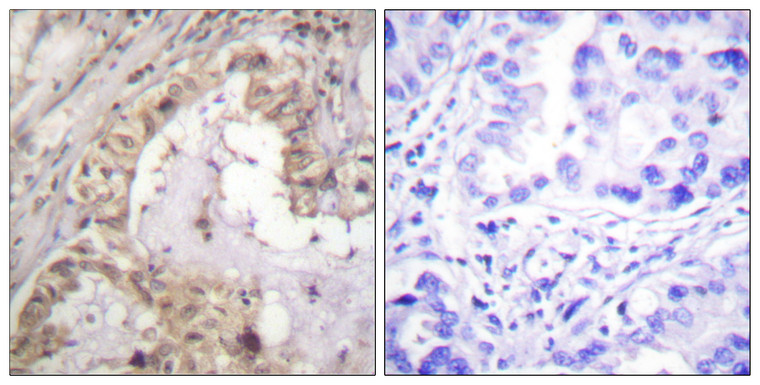| Host: |
Rabbit |
| Applications: |
WB/IHC/IF/ELISA |
| Reactivity: |
Human/Mouse/Rat |
| Note: |
STRICTLY FOR FURTHER SCIENTIFIC RESEARCH USE ONLY (RUO). MUST NOT TO BE USED IN DIAGNOSTIC OR THERAPEUTIC APPLICATIONS. |
| Short Description: |
Rabbit polyclonal antibody anti-Bcl-2-like protein 1 (13-62 aa) is suitable for use in Western Blot, Immunohistochemistry, Immunofluorescence and ELISA research applications. |
| Clonality: |
Polyclonal |
| Conjugation: |
Unconjugated |
| Isotype: |
IgG |
| Formulation: |
Liquid in PBS containing 50% Glycerol, 0.5% BSA and 0.02% Sodium Azide. |
| Purification: |
The antibody was affinity-purified from rabbit antiserum by affinity-chromatography using epitope-specific immunogen. |
| Concentration: |
1 mg/mL |
| Dilution Range: |
WB 1:500-1:2000IHC 1:100-1:300IF 1:200-1:1000ELISA 1:5000 |
| Storage Instruction: |
Store at-20°C for up to 1 year from the date of receipt, and avoid repeat freeze-thaw cycles. |
| Gene Symbol: |
BCL2L1 |
| Gene ID: |
598 |
| Uniprot ID: |
B2CL1_HUMAN |
| Immunogen Region: |
13-62 aa |
| Specificity: |
Bcl-x Polyclonal Antibody detects endogenous levels of Bcl-x protein. |
| Immunogen: |
The antiserum was produced against synthesized peptide derived from the human BCL-XL at the amino acid range 13-62 |
| Post Translational Modifications | Proteolytically cleaved by caspases during apoptosis. The cleaved protein, lacking the BH4 motif, has pro-apoptotic activity. Phosphorylated on Ser-62 by CDK1. This phosphorylation is partial in normal mitotic cells, but complete in G2-arrested cells upon DNA-damage, thus promoting subsequent apoptosis probably by triggering caspases-mediated proteolysis. Phosphorylated by PLK3, leading to regulate the G2 checkpoint and progression to cytokinesis during mitosis. Phosphorylation at Ser-49 appears during the S phase and G2, disappears rapidly in early mitosis during prometaphase, metaphase and early anaphase, and re-appears during telophase and cytokinesis. Ubiquitinated by RNF183 during prolonged ER stress, leading to degradation by the proteosome. |
| Function | Potent inhibitor of cell death. Inhibits activation of caspases. Appears to regulate cell death by blocking the voltage-dependent anion channel (VDAC) by binding to it and preventing the release of the caspase activator, CYC1, from the mitochondrial membrane. Also acts as a regulator of G2 checkpoint and progression to cytokinesis during mitosis. Isoform Bcl-X(L) also regulates presynaptic plasticity, including neurotransmitter release and recovery, number of axonal mitochondria as well as size and number of synaptic vesicle clusters. During synaptic stimulation, increases ATP availability from mitochondria through regulation of mitochondrial membrane ATP synthase F(1)F(0) activity and regulates endocytic vesicle retrieval in hippocampal neurons through association with DMN1L and stimulation of its GTPase activity in synaptic vesicles. May attenuate inflammation impairing NLRP1-inflammasome activation, hence CASP1 activation and IL1B release. Isoform Bcl-X(S) promotes apoptosis. |
| Protein Name | Bcl-2-Like Protein 1Bcl2-L-1Apoptosis Regulator Bcl-X |
| Database Links | Reactome: R-HSA-111453Reactome: R-HSA-6785807Reactome: R-HSA-844455Reactome: R-HSA-9648002Reactome: R-HSA-9692913Reactome: R-HSA-9702518 |
| Cellular Localisation | Isoform Bcl-X(L): Mitochondrion Inner MembraneMitochondrion Outer MembraneMitochondrion MatrixCytoplasmic VesicleSecretory VesicleSynaptic Vesicle MembraneCytoplasmCytosolCytoskeletonMicrotubule Organizing CenterCentrosomeNucleus MembraneSingle-Pass Membrane ProteinCytoplasmic SideAfter Neuronal StimulationTranslocates From Cytosol To Synaptic Vesicle And Mitochondrion Membrane In A Calmodulin-Dependent MannerLocalizes To The Centrosome When Phosphorylated At Ser-49 |
| Alternative Antibody Names | Anti-Bcl-2-Like Protein 1 antibodyAnti-Bcl2-L-1 antibodyAnti-Apoptosis Regulator Bcl-X antibodyAnti-BCL2L1 antibodyAnti-BCL2L antibodyAnti-BCLX antibody |
Information sourced from Uniprot.org
12 months for antibodies. 6 months for ELISA Kits. Please see website T&Cs for further guidance











